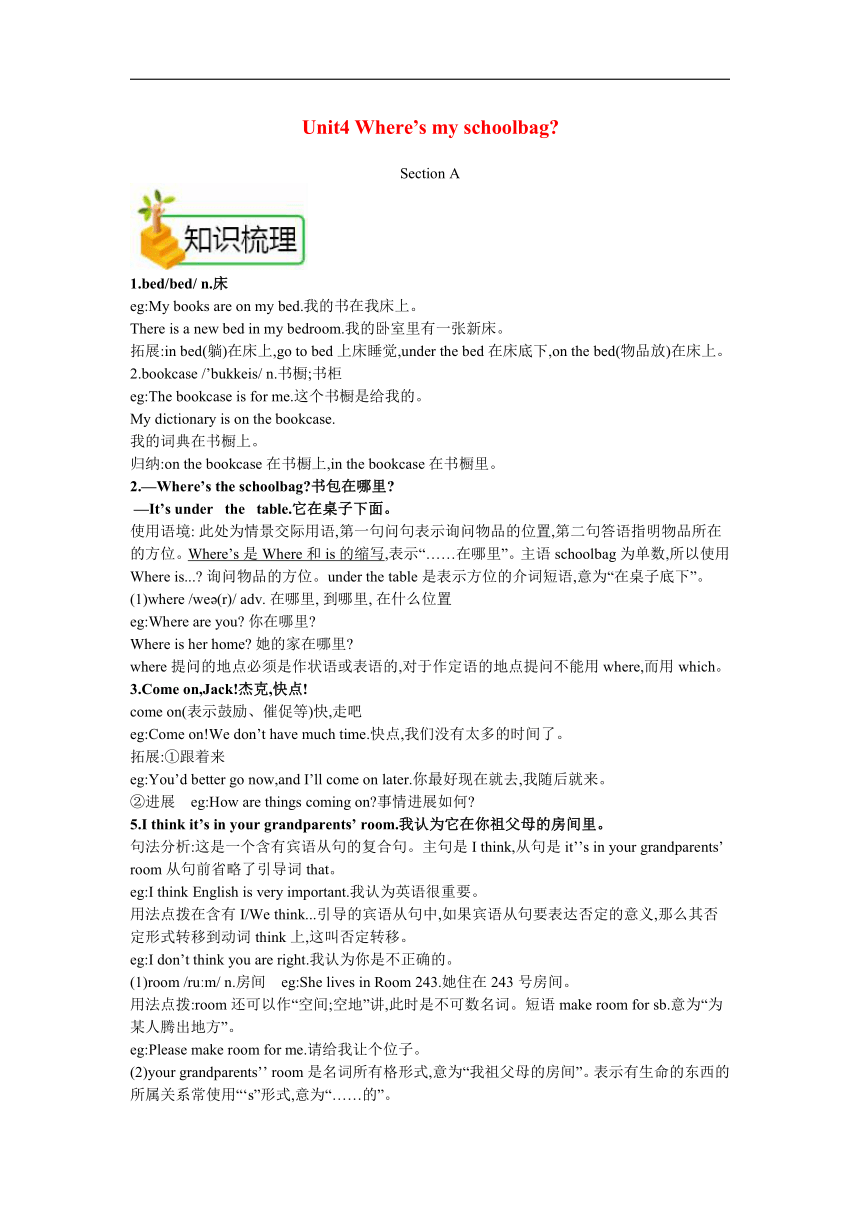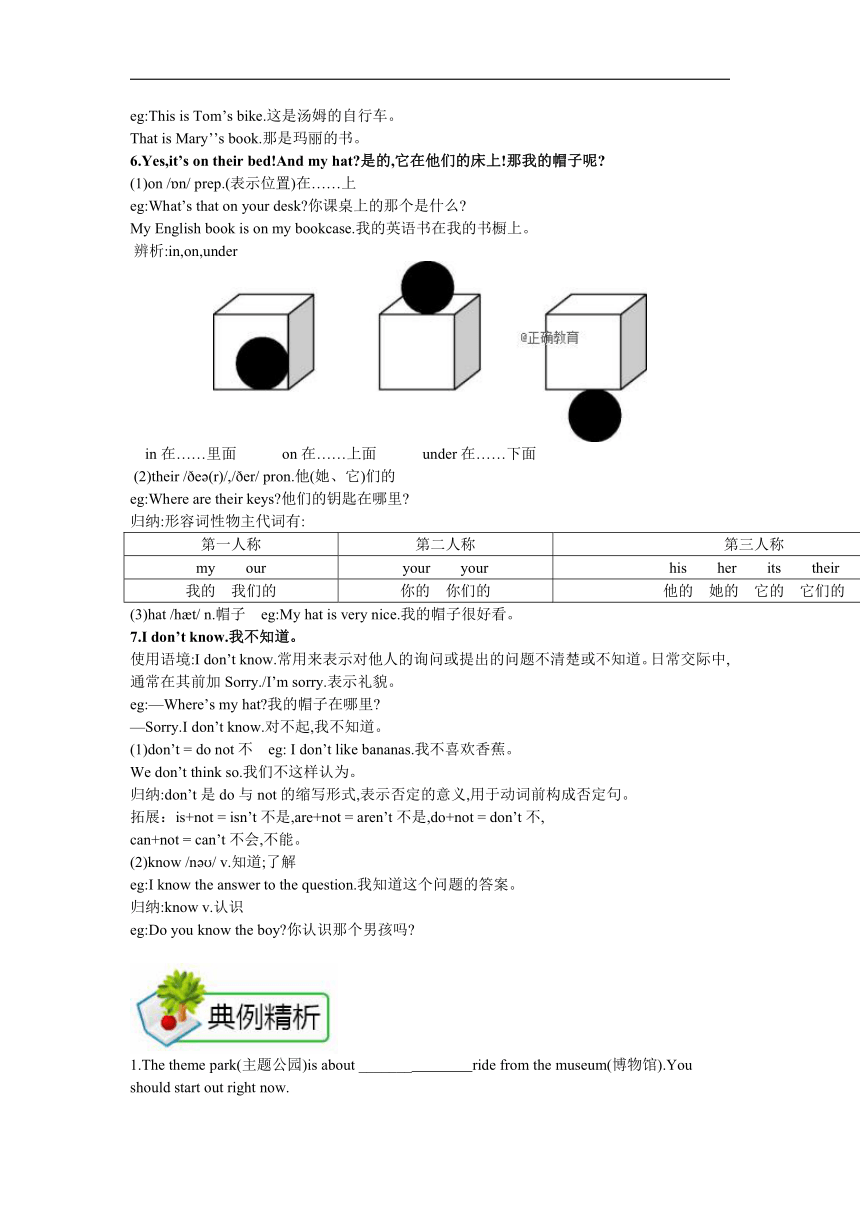Unit 4 Where’s my school bag.基础知识梳理学案
文档属性
| 名称 | Unit 4 Where’s my school bag.基础知识梳理学案 |  | |
| 格式 | zip | ||
| 文件大小 | 52.3KB | ||
| 资源类型 | 教案 | ||
| 版本资源 | 人教新目标(Go for it)版 | ||
| 科目 | 英语 | ||
| 更新时间 | 2018-09-10 08:33:43 | ||
图片预览


文档简介
Unit4 Where’s my schoolbag?
Section A
1.bed/bed/ n.床
eg:My books are on my bed.我的书在我床上。
There is a new bed in my bedroom.我的卧室里有一张新床。
拓展:in bed(躺)在床上,go to bed上床睡觉,under the bed在床底下,on the bed(物品放)在床上。2.bookcase /’bukkeis/ n.书橱;书柜
eg:The bookcase is for me.这个书橱是给我的。
My dictionary is on the bookcase.
我的词典在书橱上。
归纳:on the bookcase在书橱上,in the bookcase在书橱里。
2.—Where’s the schoolbag?书包在哪里?
?—It’s under? the? table.它在桌子下面。
使用语境:?此处为情景交际用语,第一句问句表示询问物品的位置,第二句答语指明物品所在的方位。Where’s?是Where和is的缩写,表示“……在哪里”。主语schoolbag为单数,所以使用Where is...??询问物品的方位。under the table是表示方位的介词短语,意为“在桌子底下”。?
(1)where /we?(r)/ adv.?在哪里,?到哪里,?在什么位置
eg:Where are you??你在哪里?
Where is her home??她的家在哪里?
where提问的地点必须是作状语或表语的,对于作定语的地点提问不能用where,而用which。
3.Come on,Jack!杰克,快点!
come on(表示鼓励、催促等)快,走吧
eg:Come on!We don’t have much time.快点,我们没有太多的时间了。
拓展:①跟着来
eg:You’d better go now,and I’ll come on later.你最好现在就去,我随后就来。
②进展 eg:How are things coming on?事情进展如何?
5.I think it’s in your grandparents’ room.我认为它在你祖父母的房间里。
句法分析:这是一个含有宾语从句的复合句。主句是I think,从句是it’’s in your grandparents’ room从句前省略了引导词that。
eg:I think English is very important.我认为英语很重要。
用法点拨在含有I/We think...引导的宾语从句中,如果宾语从句要表达否定的意义,那么其否定形式转移到动词think上,这叫否定转移。
eg:I don’t think you are right.我认为你是不正确的。
(1)room /ru?m/ n.房间 eg:She lives in Room 243.她住在243号房间。
用法点拨:room还可以作“空间;空地”讲,此时是不可数名词。短语make room for sb.意为“为某人腾出地方”。
eg:Please make room for me.请给我让个位子。
(2)your grandparents’’ room是名词所有格形式,意为“我祖父母的房间”。表示有生命的东西的所属关系常使用“‘s”形式,意为“……的”。
eg:This is Tom’s bike.这是汤姆的自行车。
That is Mary’’s book.那是玛丽的书。
6.Yes,it’s on their bed!And my hat?是的,它在他们的床上!那我的帽子呢?
(1)on /?n/ prep.(表示位置)在……上
eg:What’s that on your desk?你课桌上的那个是什么?
My English book is on my bookcase.我的英语书在我的书橱上。
?辨析:in,on,under
in在……里面 on在……上面 under在……下面
?(2)their /ee?(r)/,/eer/ pron.他(她、它)们的
eg:Where are their keys?他们的钥匙在哪里?
归纳:形容词性物主代词有:
第一人称
第二人称
第三人称
my our
your your
his her its their
我的 我们的
你的 你们的
他的 她的 它的 它们的
(3)hat /h?t/ n.帽子 eg:My hat is very nice.我的帽子很好看。
7.I don’t know.我不知道。
使用语境:I don’t know.常用来表示对他人的询问或提出的问题不清楚或不知道。日常交际中,通常在其前加Sorry./I’m sorry.表示礼貌。
eg:—Where’s my hat?我的帽子在哪里?
—Sorry.I don’t know.对不起,我不知道。
(1)don’t = do not?不 eg: I don’t like bananas.我不喜欢香蕉。
We don’t think so.我们不这样认为。
归纳:don’t?是do与not的缩写形式,表示否定的意义,用于动词前构成否定句。
拓展:is+not = isn’t不是,are+not = aren’t不是,do+not = don’t不,
can+not = can’t不会,不能。
(2)know /n??/ v.知道;了解
eg:I know the answer to the question.我知道这个问题的答案。
归纳:know v.认识
eg:Do you know the boy?你认识那个男孩吗?
1.The theme park(主题公园)is about _______ ride from the museum(博物馆).You should start out right now.
A.two hour?? B.two hour’s?????? C.two hours’? D. two hours
解析:考查名词所有格。
答案:C
2.Sally is very happy.There is a big smile _______her face.
A.on????? B.to?????? C.in?????? D.at
解析:考查介词。萨利非常高兴,在她脸上洋溢着欢笑。
答案:A
How to make your room clean and tidy?
?
It’s not so hard to keep your room clean and tidy. You’ve worked hard and now your room is clean and tidy. It makes you feel great,doesn’t it? Now you only need to keep it that way. The following steps will help you.
Step 1: Get into the habit of making your bed before you leave the room. A dirty bed can make a clean room look dirty. This small step can let you keep your room clean and tidy the whole day.
Step 2: Keep food out of your room. Because all of those dirty dishes and paper can make a room dirty fast. If you must eat food in your room,bring dishes back to the kitchen and take out all the trash(垃圾) when you finish eating your food.
Step3: Put things back where they were. This is the simplest rule. If you follow it,you will never have to worry about your room being dirty again.
Step4: Whenever you get home from school or work,change your clothes right away and put them away so that they won’t just be lying on the bed.
Step5: If you have a party with your friends,make sure to pick up the trash and clean your house as soon as they leave.
Unit 4 Where's my schoolbag?
Section B &Self-check
1. radio /’reidi?u /? n.无线电广播,收音机
radio的复数形式在词尾加s,即radios。以o结尾的名词变复数加s的还有zoo,photo等。
2.clock?/kl?? k/?n.时钟 eg:A clock is on the wall.墙上有一块时钟。
辨析:clock,watch clock指“时钟”,而watch指“手表”。
eg:I have a watch.我有一块手表。It’s a clock.它是一块时钟。
3.player /’ple i ?(r)/ n.播放机 eg:My player is very nice.我的播放机很漂亮。
拓展(1)player n.运动员
eg:Yao Ming is a great player.姚明是一位伟大的运动员。
(2)tape player录音机 eg:What color is your tape player?你的录音机是什么颜色?
4.model /’m ? d ? l/ n.模型
eg:The model of the ship is white.这艘轮船的模型是白色的。
5.plane /plein/ n.飞机 eg:Where’s your paper(纸)plane?你的纸飞机在哪里?
拓展:model plane飞机模型
eg:Many children like making model planes.许多孩子喜欢做飞机模型。
6.I’m tidy,but Gina is not.我爱整洁,但吉娜不是这样。
句法分析:but是转折连词,意为“然而,可是”,用于连接前后两个意义上差别很大的句子。
(1)but /b?t/ conj.但是 eg:The boy is 2 years old,but he knows many words.这个小男孩仅两岁,但他认识许多字。
(2)tidy /’ta?d?/ adj.整洁的;井井有条的 eg:My room is tidy.我的房间井井有条。
7.In our room,my books and tapes are in the bookcase.在我们的房间里,我的书和磁带在书橱里。
our /’au?/ pron.我们的 eg:This is our school.这是我们的学校。
our是形容词性物主代词,这类词不能单独使用,后面要接名词。若后面没有名词,则要用名词性物主代词。
8....Gina always asks.……吉娜总是问。
always /’??lwe?z/ adv.总是
eg:They always watch TV on Sundays.他们总是在星期天看电视。
拓展:always可用于进行时态,表示“总是,一直”,是一种加强语气的说法,含有“不耐烦、赞赏、不满”等感彩。 eg:He’s always helping others.他总是帮助别人。
Mary is always coming late.玛丽总是迟到。
9.My pencil box is in my schoolbag and my schoolbag is under the desk.我的文具盒在我的书包里,我的书包在书桌下面。
结构分析:这是一个由并列连词and连接的并列句。其结构是“简单句+并列连词+简单句”。?and可以连接两个句子,也可以连接两个词或短语,但连接的两个成分应一致。
归纳:(1)and在连接两个或两个以上的表示不同的人或事物的单数名词或不可数名词作主语时,谓语动词用复数形式。
eg:My pen and his pencil are in the pencil box.我的钢笔和他的铅笔在文具盒里。
(2)在否定句中连接两个宾语时,and需要换成or。
eg:I don’t like eggs or milk.我不喜欢鸡蛋和牛奶。
例1 Edward,you have grown up.You should learn to make your own room .
A.empty?????? B.noisy? C.dirty?? ??? D.tidy
解析:考查形容词辨析。句意为:爱德华,你已经长大了,你应该学会让自己的房间干净整洁。
答案:D
例2—Miss Zhou is very popular with the students.
—Yes.Her classes are lively and interesting.
A.always????? B.sometimes ?C.hardly
解析:副词的辨析。A.总是? B. 有时 C .几乎不。
答案: A
例3?—Is this ruler??
—No. is over there.
A.her;Her???? B.her;Hers??? C.hers;Hers? D.hers;Her
解析:考查形容词性物主代词和名词性物主代词的区别和用法。
答案:B
Section A
1.bed/bed/ n.床
eg:My books are on my bed.我的书在我床上。
There is a new bed in my bedroom.我的卧室里有一张新床。
拓展:in bed(躺)在床上,go to bed上床睡觉,under the bed在床底下,on the bed(物品放)在床上。2.bookcase /’bukkeis/ n.书橱;书柜
eg:The bookcase is for me.这个书橱是给我的。
My dictionary is on the bookcase.
我的词典在书橱上。
归纳:on the bookcase在书橱上,in the bookcase在书橱里。
2.—Where’s the schoolbag?书包在哪里?
?—It’s under? the? table.它在桌子下面。
使用语境:?此处为情景交际用语,第一句问句表示询问物品的位置,第二句答语指明物品所在的方位。Where’s?是Where和is的缩写,表示“……在哪里”。主语schoolbag为单数,所以使用Where is...??询问物品的方位。under the table是表示方位的介词短语,意为“在桌子底下”。?
(1)where /we?(r)/ adv.?在哪里,?到哪里,?在什么位置
eg:Where are you??你在哪里?
Where is her home??她的家在哪里?
where提问的地点必须是作状语或表语的,对于作定语的地点提问不能用where,而用which。
3.Come on,Jack!杰克,快点!
come on(表示鼓励、催促等)快,走吧
eg:Come on!We don’t have much time.快点,我们没有太多的时间了。
拓展:①跟着来
eg:You’d better go now,and I’ll come on later.你最好现在就去,我随后就来。
②进展 eg:How are things coming on?事情进展如何?
5.I think it’s in your grandparents’ room.我认为它在你祖父母的房间里。
句法分析:这是一个含有宾语从句的复合句。主句是I think,从句是it’’s in your grandparents’ room从句前省略了引导词that。
eg:I think English is very important.我认为英语很重要。
用法点拨在含有I/We think...引导的宾语从句中,如果宾语从句要表达否定的意义,那么其否定形式转移到动词think上,这叫否定转移。
eg:I don’t think you are right.我认为你是不正确的。
(1)room /ru?m/ n.房间 eg:She lives in Room 243.她住在243号房间。
用法点拨:room还可以作“空间;空地”讲,此时是不可数名词。短语make room for sb.意为“为某人腾出地方”。
eg:Please make room for me.请给我让个位子。
(2)your grandparents’’ room是名词所有格形式,意为“我祖父母的房间”。表示有生命的东西的所属关系常使用“‘s”形式,意为“……的”。
eg:This is Tom’s bike.这是汤姆的自行车。
That is Mary’’s book.那是玛丽的书。
6.Yes,it’s on their bed!And my hat?是的,它在他们的床上!那我的帽子呢?
(1)on /?n/ prep.(表示位置)在……上
eg:What’s that on your desk?你课桌上的那个是什么?
My English book is on my bookcase.我的英语书在我的书橱上。
?辨析:in,on,under
in在……里面 on在……上面 under在……下面
?(2)their /ee?(r)/,/eer/ pron.他(她、它)们的
eg:Where are their keys?他们的钥匙在哪里?
归纳:形容词性物主代词有:
第一人称
第二人称
第三人称
my our
your your
his her its their
我的 我们的
你的 你们的
他的 她的 它的 它们的
(3)hat /h?t/ n.帽子 eg:My hat is very nice.我的帽子很好看。
7.I don’t know.我不知道。
使用语境:I don’t know.常用来表示对他人的询问或提出的问题不清楚或不知道。日常交际中,通常在其前加Sorry./I’m sorry.表示礼貌。
eg:—Where’s my hat?我的帽子在哪里?
—Sorry.I don’t know.对不起,我不知道。
(1)don’t = do not?不 eg: I don’t like bananas.我不喜欢香蕉。
We don’t think so.我们不这样认为。
归纳:don’t?是do与not的缩写形式,表示否定的意义,用于动词前构成否定句。
拓展:is+not = isn’t不是,are+not = aren’t不是,do+not = don’t不,
can+not = can’t不会,不能。
(2)know /n??/ v.知道;了解
eg:I know the answer to the question.我知道这个问题的答案。
归纳:know v.认识
eg:Do you know the boy?你认识那个男孩吗?
1.The theme park(主题公园)is about _______ ride from the museum(博物馆).You should start out right now.
A.two hour?? B.two hour’s?????? C.two hours’? D. two hours
解析:考查名词所有格。
答案:C
2.Sally is very happy.There is a big smile _______her face.
A.on????? B.to?????? C.in?????? D.at
解析:考查介词。萨利非常高兴,在她脸上洋溢着欢笑。
答案:A
How to make your room clean and tidy?
?
It’s not so hard to keep your room clean and tidy. You’ve worked hard and now your room is clean and tidy. It makes you feel great,doesn’t it? Now you only need to keep it that way. The following steps will help you.
Step 1: Get into the habit of making your bed before you leave the room. A dirty bed can make a clean room look dirty. This small step can let you keep your room clean and tidy the whole day.
Step 2: Keep food out of your room. Because all of those dirty dishes and paper can make a room dirty fast. If you must eat food in your room,bring dishes back to the kitchen and take out all the trash(垃圾) when you finish eating your food.
Step3: Put things back where they were. This is the simplest rule. If you follow it,you will never have to worry about your room being dirty again.
Step4: Whenever you get home from school or work,change your clothes right away and put them away so that they won’t just be lying on the bed.
Step5: If you have a party with your friends,make sure to pick up the trash and clean your house as soon as they leave.
Unit 4 Where's my schoolbag?
Section B &Self-check
1. radio /’reidi?u /? n.无线电广播,收音机
radio的复数形式在词尾加s,即radios。以o结尾的名词变复数加s的还有zoo,photo等。
2.clock?/kl?? k/?n.时钟 eg:A clock is on the wall.墙上有一块时钟。
辨析:clock,watch clock指“时钟”,而watch指“手表”。
eg:I have a watch.我有一块手表。It’s a clock.它是一块时钟。
3.player /’ple i ?(r)/ n.播放机 eg:My player is very nice.我的播放机很漂亮。
拓展(1)player n.运动员
eg:Yao Ming is a great player.姚明是一位伟大的运动员。
(2)tape player录音机 eg:What color is your tape player?你的录音机是什么颜色?
4.model /’m ? d ? l/ n.模型
eg:The model of the ship is white.这艘轮船的模型是白色的。
5.plane /plein/ n.飞机 eg:Where’s your paper(纸)plane?你的纸飞机在哪里?
拓展:model plane飞机模型
eg:Many children like making model planes.许多孩子喜欢做飞机模型。
6.I’m tidy,but Gina is not.我爱整洁,但吉娜不是这样。
句法分析:but是转折连词,意为“然而,可是”,用于连接前后两个意义上差别很大的句子。
(1)but /b?t/ conj.但是 eg:The boy is 2 years old,but he knows many words.这个小男孩仅两岁,但他认识许多字。
(2)tidy /’ta?d?/ adj.整洁的;井井有条的 eg:My room is tidy.我的房间井井有条。
7.In our room,my books and tapes are in the bookcase.在我们的房间里,我的书和磁带在书橱里。
our /’au?/ pron.我们的 eg:This is our school.这是我们的学校。
our是形容词性物主代词,这类词不能单独使用,后面要接名词。若后面没有名词,则要用名词性物主代词。
8....Gina always asks.……吉娜总是问。
always /’??lwe?z/ adv.总是
eg:They always watch TV on Sundays.他们总是在星期天看电视。
拓展:always可用于进行时态,表示“总是,一直”,是一种加强语气的说法,含有“不耐烦、赞赏、不满”等感彩。 eg:He’s always helping others.他总是帮助别人。
Mary is always coming late.玛丽总是迟到。
9.My pencil box is in my schoolbag and my schoolbag is under the desk.我的文具盒在我的书包里,我的书包在书桌下面。
结构分析:这是一个由并列连词and连接的并列句。其结构是“简单句+并列连词+简单句”。?and可以连接两个句子,也可以连接两个词或短语,但连接的两个成分应一致。
归纳:(1)and在连接两个或两个以上的表示不同的人或事物的单数名词或不可数名词作主语时,谓语动词用复数形式。
eg:My pen and his pencil are in the pencil box.我的钢笔和他的铅笔在文具盒里。
(2)在否定句中连接两个宾语时,and需要换成or。
eg:I don’t like eggs or milk.我不喜欢鸡蛋和牛奶。
例1 Edward,you have grown up.You should learn to make your own room .
A.empty?????? B.noisy? C.dirty?? ??? D.tidy
解析:考查形容词辨析。句意为:爱德华,你已经长大了,你应该学会让自己的房间干净整洁。
答案:D
例2—Miss Zhou is very popular with the students.
—Yes.Her classes are lively and interesting.
A.always????? B.sometimes ?C.hardly
解析:副词的辨析。A.总是? B. 有时 C .几乎不。
答案: A
例3?—Is this ruler??
—No. is over there.
A.her;Her???? B.her;Hers??? C.hers;Hers? D.hers;Her
解析:考查形容词性物主代词和名词性物主代词的区别和用法。
答案:B
同课章节目录
- starters 预备篇(2012秋审查)
- Unit 1 Good morning !
- Unit 2 What’s this in English?
- Unit 3 What color is it ?
- Unit 1 My name's Gina.
- Section A
- Section B
- Unit 2 This is my sister.
- Section A
- Section B
- Unit 3 Is this your pencil?
- Section A
- Section B
- Unit 4 Where's my schoolbag?
- Section A
- Section B
- Unit 5 Do you have a soccer ball?
- Section A
- Section B
- Unit 6 Do you like bananas?
- Section A
- Section B
- Unit 7 How much are these socks?
- Section A
- Section B
- Unit 8 When is your birthday?
- Section A
- Section B
- Unit 9 My favorite subject is science.
- Section A
- Section B
